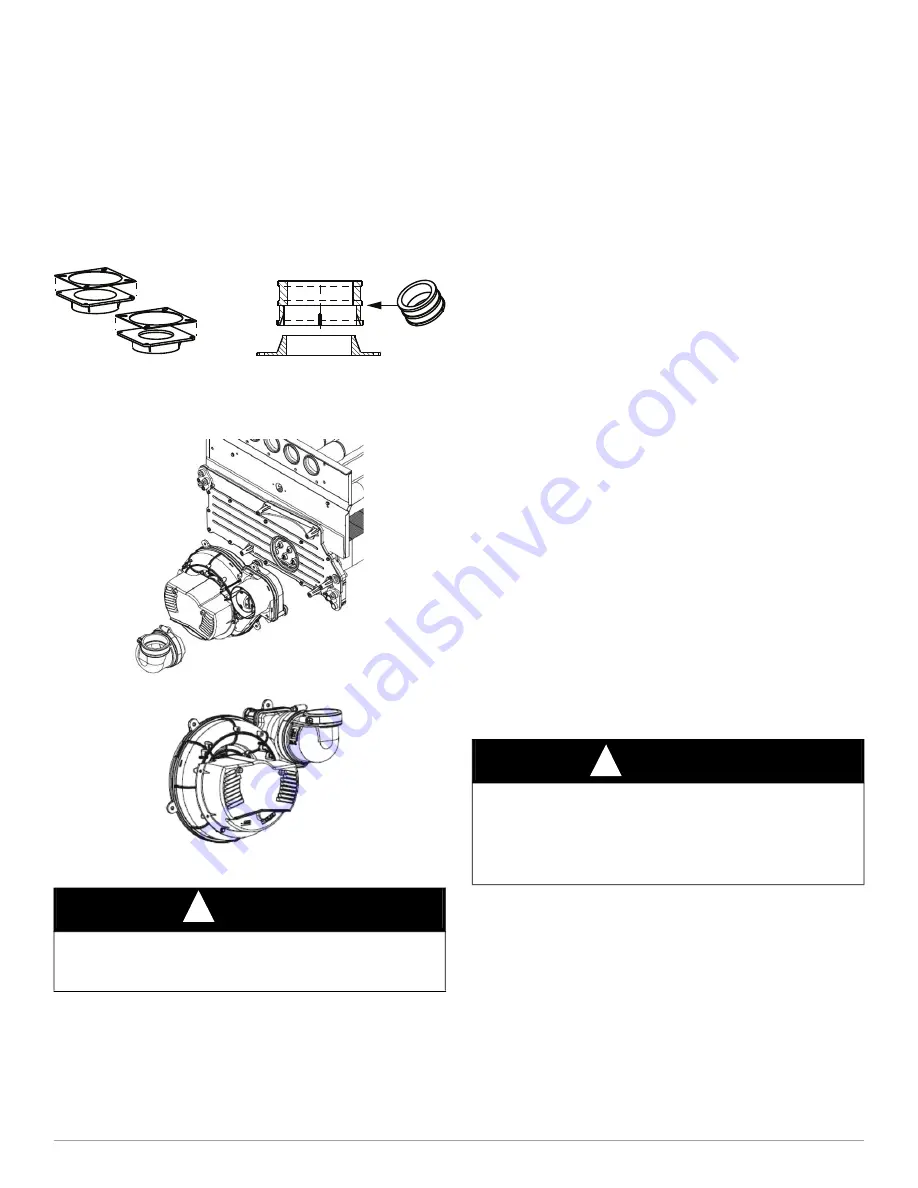
59CU5A: Installation, Start-up, Operating and Service and Maintenance Instructions
Manufacturer reserves the right to change, at any time, specifications and designs without notice and without obligations.
37
can pass through the vent pipe adapter; it cannot pass through the inlet
pipe adapter.
2. Align the screw holes in the plastic vent pipe adapter with the
dimples in the casing.
3. Pilot drill the screw holes for the adapter in the casing and attach
the vent pipe adapter to the furnace with sheet metal screws
4. Slide the end of the rubber vent coupling with notches in it over the
standoffs on the vent pipe adapter.
5. Insert a length of vent pipe through the coupling into the outlet of
the vent elbow.
6. Tighten the clamp around the outlet of the vent elbow. Torque the
clamp to 15 lb-in.
A13074
Fig. 53 – Vent Coupling and Adapter with Gaskets
A200367
Fig. 54 – Inducer Vent Elbow
The following instructions are for PVC/ABS DWV vent piping only.
Install the remaining vent and combustion air pipes as shown below. It is
recommended that all pipes be cut, prepared, and pre-assembled before
permanently cementing any joint.
1. Working from furnace to outside, cut pipe to required length(s).
2. De-burr inside and outside of pipe.
3. Chamfer outside edge of pipe for better distribution of primer and
cement.
4. Complete the vent and combustion air pipe installation by
connecting the concentric vent or by installing the required
termination elbows, see
.
For Ventilated Combustion Air Termination, see
.
5. Clean and dry all surfaces to be joined.
6. Check dry fit of pipe and mark insertion depth on pipe.
7. Insert the vent pipe into the vent elbow.
8. Torque clamp on vent elbow 15 lb-in.
9. Torque clamp on vent coupling 15 lb-in.
10. Insert the combustion air pipe into the adapter.
11. Pilot drill a screw hole through the adapter into the combustion air
pipe and secure the pipe to the adapter with sheet metal screws.
DO
NOT DRILL INTO POLYPROPYLENE VENT PIPES.
Use an
optional accessory vent coupling, if needed.
12. Seal around the combustion air pipe with silicone or foil tape.
SILICONE SEALERS MAY NOT BE APPROPRIATE FOR
POLYPROPYLENE
VENT
SYSTEMS.
SEE
POLYPROPYLENE VENT SYSTEM MANUFACTURER’S
INSTRUCTIONS.
13. After pipes have been cut and pre-assembled, apply generous layer
of cement primer to pipe fitting socket and end of pipe to insertion
mark. Quickly apply approved cement to end of pipe and fitting
socket (over primer). Apply cement in a light, uniform coat on
inside of socket to prevent buildup of excess cement. Apply second
coat.
DO NOT CEMENT POLYPROPYLENE FITTINGS.
14. While cement is still wet, twist pipe into socket with 1/4-in.
turn.
Be sure pipe is fully inserted into fitting socket.
15. Wipe excess cement from joint. A continuous bead of cement will
be visible around perimeter of a properly made joint.
16. Handle pipe joints carefully until cement sets.
17. Horizontal portions of the venting system shall be supported to
prevent sagging. Space combustion air piping and vent piping
hangers, see
. Support pipes using perforated metal
hanging strap or commercially available hangers or straps designed
to support plastic pipe.
18. Slope the vent and combustion air piping downward towards
furnace. A minimum slope of at least 1/4-in. (6 mm) per linear
ft.(1-in (25 mm) per 4 ft.(1.2 M)) with no sags between hangers is
required. See Caution Box below.
19. Use appropriate methods to seal openings where combustion air
pipe and vent pipe pass through roof or sidewall.
NOTICE
!
DO NOT USE THESE TECHNIQUES FOR POLYPROPYLENE
VENT PIPING SYSTEMS. See the polypropylene vent system manu
-
facturer’s instructions for installing polypropylene venting systems.
Attach gaskets to vent pipe and
combustion air adapters.
Vent Coupling and Adapter
CAUTION
!
FURNACE RELIABILITY HAZARD
Failure to follow this caution may result in nuisance short cycling,
frozen vent termination, and/or no heat.
Slope the vent and combustion air piping downward towards furnace a
minimum of 1/4-in. (6 mm) per linear ft. of pipe.
















































